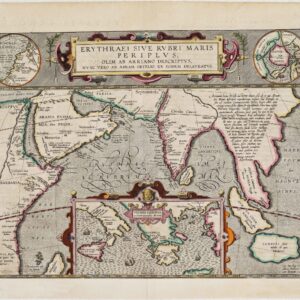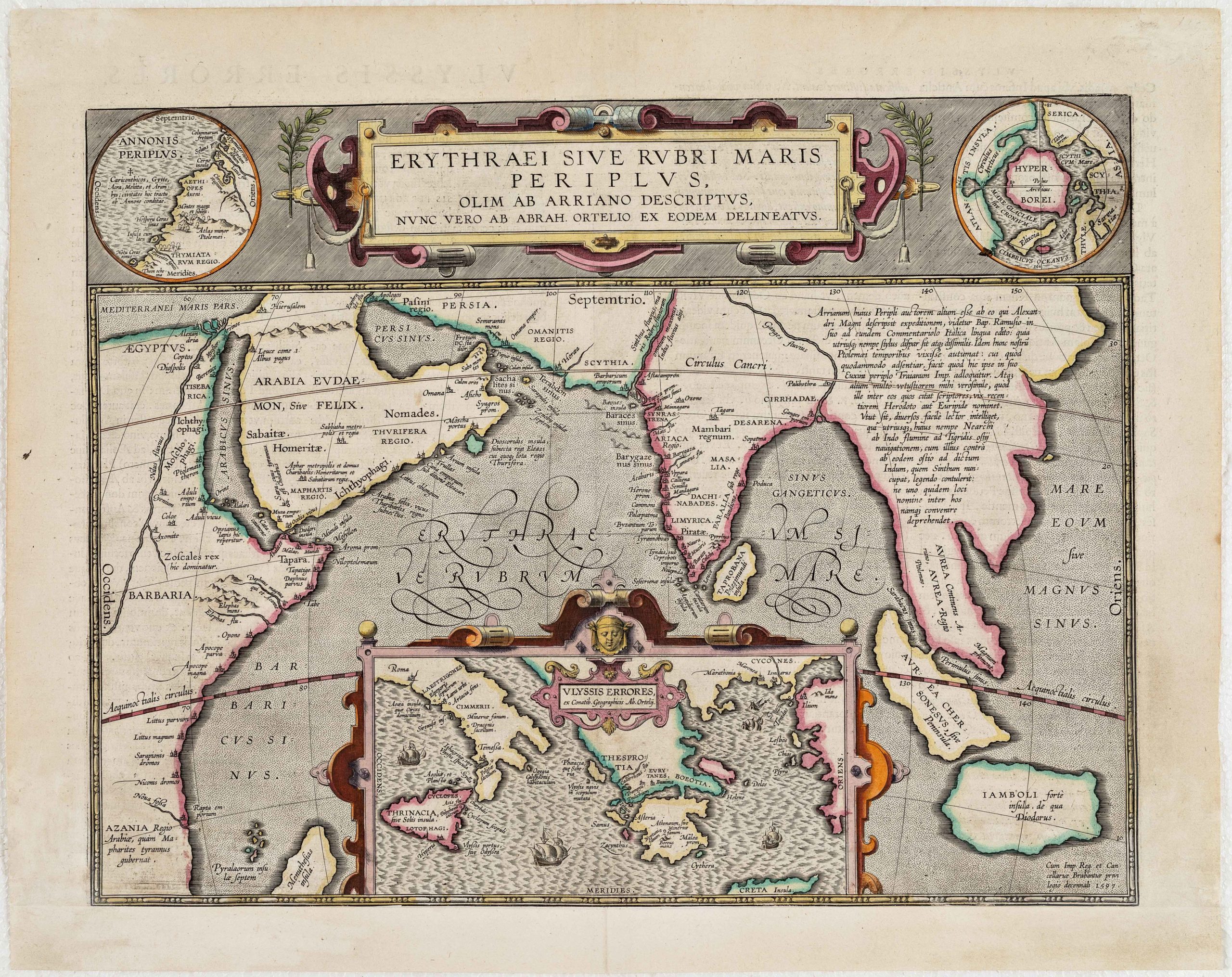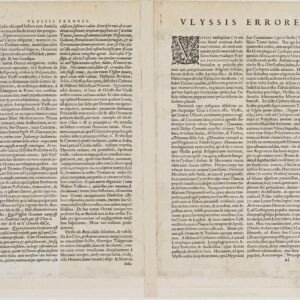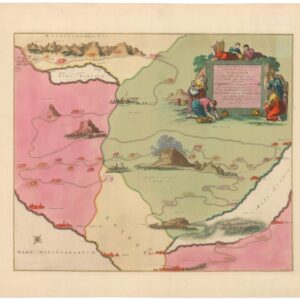A stunning depiction of the Holy Cities of Islam.
[Ottoman Hajj scroll with a personalized incantation].
$6,500
1 in stock
Description
This is an Ottoman-era Islamic pilgrimage or hajj scroll, which, based on the inscriptions, dates to July 1829. It is a manuscript illustration depicting the Muslim pilgrimage route in Western Arabia, specifically the holy sites in Mecca and Medina. The composition is rendered in a stylized, bird’s-eye view format that is typical of Ottoman religious cartography.
Among its key pictorial features is the Kaaba, located at the very top of the scroll. This is the sacred, cube-shaped structure at the center of the Masjid al-Haram in Mecca. The Kaaba is surrounded by a colonnaded courtyard with minarets, domes, and is fronted by the Maqam Ibrahim (Station of Abraham), a small, glass-and-gold structure.
Moving down the scroll, the imagery includes a number of ritual stations associated with the Hajj, mostly depicted in the form of brightly colored tents and stands. While the tents are likely representations of the Mina, Muzdalifah, and Arafat stations, where various rites of the Hajj are performed, the stone pillars serve as a tangible representation of the devil. They constitute an essential part of the hajj ritual, in which pilgrims chase away evil by stoning the pillars. The dangling red shapes may well constitute the stacks of stones gathered for the pilgrims in advance.
Near the bottom of the scroll, in the fourth panel from the top, the large complex represents the Prophet’s Mosque (Al-Masjid an-Nabawi) in Madinah, identifiable by its characteristic green dome, which is where the tomb of the Prophet Muhammad is located. Adjacent buildings and minarets signify other important religious and historical sites within Madinah.
The entire pictorial composition consists of five panels, which are framed by elaborate Arabic calligraphy that surrounds the whole piece. Other than a few labels for sacred locations (e.g., الكعبة [al-Ka’bah]; زمزم [Well of Zamzam]; مقام إبراهيم [Maqām Ibrāhīm]; and المسجد النبوي [al-Masjid al-Nabawī]), these are all carefully selected Qur’anic verses, meant to contextualize the imagery for Muslims.
A complete translation of the text is provided below, but to illustrate the contextualizing trend, it is worth noting that one of the most prominent verses is from Sura al-Imran (3:97), which addresses the obligation for Muslims to participate in the Hajj. Interspersed within the calligraphic border, we also find four directional markers, similar in style to European compass roses. Such markers are relatively typical in Islamic manuscript maps and usually serve to align the view with the correct qibla, the direction of prayer.
Translation of the calligraphy
Front (Ornamented Page)
بسم الله الرحمن الرحيم
In the Name of Allah, the Most Compassionate, Most Merciful.
قُل إنَّ الحقَّ من ربكم
Say, “Indeed, the Truth is from your Lord.”
فَاتَّبِعُوا أثَرَ إبراهيمَ حَنِيفاً
So follow the example of Abraham the Upright,
ما كان من المشركين
who was not of those who associate partners with God.
أولَ بيتٍ وُضعَ للناسِ
The first House [of worship] established for humankind
لَلهُ،
is that at Bakkah,
مَبارَكٌ وَهُدىً لِّلعالَمينَ
a blessed sanctuary and guidance for all people.
فيه آياتٌ بَيناتٌ ومَقامُ إبراهيمَ
In it are clear signs and the Station of Abraham.
مَن دَخَلهُ كان آمِنًا
Whoever enters it is safe.
وَأُمرتم بالحَجِّ إليهِ
And pilgrimage to this House is an obligation by Allah upon those who are able.
مَن كَفَرَ فَإِنَّ اللهَ غَنِيٌّ عَنهُ
And whoever disbelieves, then surely Allah is Free of need of all creation.
(Qur’an 3:95–97)
إِنَّا فَتَحْنَا لَكَ فَتحًا مُبِينًا
Indeed, We have granted you a clear victory,
لِيَغفِرَ لَكَ اللهُ مَا تَقَدَّمَ مِن ذَنبِكَ وما تَأخَّرَ
so that Allah may forgive you your past and future sins,
وَيُتِمَّ نِعمَتَهُ عَلَيكَ وَيَهديكَ صِرَاطًا مُستَقيمًا
and perfect His favor upon you, and guide you to the Straight Path,
وَيَنصُرَكَ نَصْرًا عَزيزًا
and grant you mighty assistance.
(Qur’an 48:1–3)
كَتَبَهُ وعَلَّقَهُ المسكينُ محمدُ عبد الباري بن محمد أمين، خادمُ العلمِ بالمسجد النبويِّ
It was scribed and finely composed by the humble Muhammad ʿAbd al-Bari ibn Muhammad Amin, servant of knowledge at the Prophet’s Mosque.
Verso
While the front contains much of the calligraphy, most of this is formal incantation rooted in the Quran. The verso text is in many ways more interesting, as it provides personal details and aspirations that transform this formulaic map into something more intimate and human. In addition to giving a birth date for the scroll’s recipient – July 25, 1829 – the dedicatory text also establishes that this scroll was most likely commissioned during the Hajj of 1830. As the Islamic calendar follows a lunar year, dates shift in relation to the Gregorian calendar. In 1829, the Islamic year 1245 AH began on July 3. The subsequent month of Dhu al-Hijjah, during which the hajj pilgrimage takes place, would not commence until May 24, 1830. It is thus likely that this scroll was made for the newborn during the hajj of that year.
The verso text can essentially be divided into three distinct sections: a historical date and birth notice, identifying not only the recipient but also the spiritual motivation behind the scroll’s creation; a supplication for the Hajj and Umrah (minor pilgrimage); and, last but not least, a devotional poem. All three have been translated below:
Historical Date & Birth Notice
“On the fifteenth day of the Blessed Month (Safar), in the year 1245 AH, a noble and pure newborn was delivered: al-Muʿizz, son of al-Muntasir bi-Llāh, son of Muhammad al-Taʾī. May Allah make him a delight to his parents and bless him with piety.”
Supplication for hajj and umrah
“O Allah, grant us the opportunity to perform Hajj and ʿUmrah this year, and accept them from us—indeed, You are the All-Hearing, the All-Knowing.”
Devotional Poem
You are the refuge of lost hearts,
The sanctuary of the poor and broken,
The goal of yearning travellers.
Here I stand—my soul and body—at Your door:
If You turn me away, to whom shall I turn?
If You reject me, where shall I go?
So I beseech You by Your mercy and bounty,
Accept me,
And enroll me among Your nearest servants.
May Allah’s blessings and peace be upon Muhammad,
the best of all creation,
and upon his pure family and companions.
Census
Hajj scrolls exist in a broad variety, dating across a range of centuries, and making their sub-classification somewhat arbitrary. Scrolls such as these were produced throughout the Islamic world, particularly in the Ottoman Middle East and North Africa. They were a common commodity sold to pilgrims during the Hajj, and thus, a considerable industry also existed in the Ottoman Hijaz. As Neatline’s example reveals, these scrolls, although hand-painted, often had a highly decorative yet generic front and could then be personalized on the verso. Much as is the case here. Their nature as hand-drawn and subsequently personalized makes most such scrolls unique. In addition to the Hajj itself, our scroll was associated with the birth of a child, who would have otherwise remained historically obscure. As a consequence of the way these scrolls were made and distributed – and augmented by the fact that artisans in the Islamic world rarely are recognized by name – finding two identical hajj scrolls is quite rare.
While our scroll has no exact parallels, notable institutional and private collections of Islamic art hold similar documents. These include the private Khalili Collection of Hajj and the Arts of Pilgrimage, an extensive collection with more than 5,000 items related to the Hajj; the Museum of Islamic Art in Doha, which holds and displays a number of pilgrimage scrolls; and The British Museum, which also has an extensive collection of Islamic objects related to Islamic pilgrimage. Finally, a hajj certificate from around the same period as our scroll (19th century) is held by The British Library (OCLC 499857217).
Cartographer(s):
Condition Description
Minor wear.
References
![[Data Visualization – Early Zionist Movement Atlas] Palästina-Wirtschafts-Atlas.](https://neatlinemaps.com/wp-content/uploads/2025/06/NL-02406-1_thumbnail-300x300.jpg)



![[With Extensive Contemporary Annotations] Ordnance Survey of the Peninsula of Sinai Made in 1868-9.](https://neatlinemaps.com/wp-content/uploads/2020/05/NL-00842_Thumbnail-300x300.jpg)
![[With Extensive Contemporary Annotations] Ordnance Survey of the Peninsula of Sinai Made in 1868-9.](https://neatlinemaps.com/wp-content/uploads/2020/05/NL-00842-scaled.jpg)
![[With Extensive Contemporary Annotations] Ordnance Survey of the Peninsula of Sinai Made in 1868-9.](https://neatlinemaps.com/wp-content/uploads/2020/05/NL-00842-scaled-300x300.jpg)
